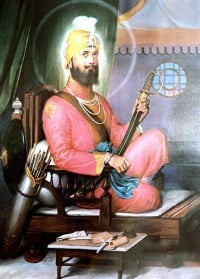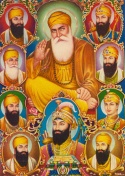Sikhism: Its beliefs,
practices, symbol, & names
Sikh Beliefs:
| Goal: The goal of every Sikh is to build a close, loving relationship with God. | |
Deity: Sikhs believe in a single, Formless God, with many names, who can be known through meditation. his concept is similar to Islam whose followers believe in a single God who has 99 names. The Mool Mantar, the first hymn composed by Guru Nanak, is recited daily by many Sikhs. It contains a description of many of the attributes of God: There is only one God; His Name is Truth; He is the Creator; He is without fear; He is without hate; He is beyond time (i.e. is immortal); He is beyond birth and death; He is self-existent. 1 Only he can be worshiped. Rahras, a Sikh evening prayer states:"[O God] since I have fallen at your feet, I do not care for anybody else. I do not follow the religious ways preached by various religions believing in Ram, Mohammed, Puran or Qur'an. The Simritis, Shastras and the Vedas lay down different doctrines. But I do not recognize any of these. O God, I have written these hymns with your grace and kindness. All that has been said is in fact spoken by you." 2 | |
Reincarnation: They believe in samsara (the repetitive cycle of birth, life and death), karma (the accumulated sum of one's good and bad deeds, and reincarnation the belief of a rebirth following death. These beliefs are similar to Hinduism."Each individual has many reincarnations, but being born a human means the soul is nearing the end of rebirth. God judges each soul at death and may either reincarnate the soul or, if pure enough, allow it to rest with him." | |
| Caste system: Sikhs have rejected the caste system of the Hindu religion. They believe that everyone has equal status in the eyes of God. This is a very important principle that permeates all Sikh beliefs, behaviors, and rituals. | |
Code of Conduct: During the 18th century, there were a number of attempts to prepare an accurate portrayal of Sikh customs. None received the support of most Sikhs. Sikh scholars and theologians started in 1931 to prepare the Reht Maryada -- the Sikh code of conduct and conventions. It is "the only version authorized by the Akal Takht, the seat of supreme temporal authority for Sikhs. It's implementation has successfully achieved a high level of uniformity in the religious and social practices of Sikhism" throughout the world. It contains 27 articles. Article 1 defines who is a Sikh:"Any human being who faithfully believes in | |
| There are a number of traditions within Sikhism. Thousands of Sikhs, both in India and worldwide, follow living gurus who have lineages traceable back to Guru Gobind Singh. In Canada and elsewhere, major strains are becoming evident between liberal and conservative wings of the religion, as some Sikhs accommodate to the surrounding culture. |
Sikh Practices:
| Prayers: repeated multiple times each day. | |
| Worship: Sikhs are prohibited from worshipping idols, images, or icons. | |
| Temples: There are over 200 Gurdwaras (temples, shrines or holy places) in India alone. The most sacred is Harmandir Sahib, the Golden Temple, at Amritsar. However, all places where the Sri Guru Granth Sahib is installed are equally holy. | |
The Five K's: These are clothing practices followed by stricter Sikhs, called Khalsa saints:
| |
| The Sikh Code of Conduct states, "A Sikh must not take hemp, opium, liquor, tobacco, or any intoxicant." Drinking of alcoholic beverages or smoking is thus forbidden. |
 The Khanda -- the Sikh symbol
The Khanda -- the Sikh symbol
The Khanda is the main Sikh symbol. It is seen at the top of this essay, used by permission of www.hatisoft.com 4 It is composed of four items, all traditional Sikh weapons:| A vertical double edged sword with a broad blade, also called a Khanda. | |
| Two curved swords, called kirpans. They are called miri and piri, after the names given to his personal kirpans by Guru Hargobind. | |
| A ring called a chakker (aka chakram). It is a very effective weapon, with a range of up to 50 meters (165 feet). This has been popularized in North America by the television series Xena the Warrior Princess. |
"The Sikh emblem, Khanda, contains a ring of steel representing the Unity of God, a two edged sword symbolizing God's concern for truth and justice, and two crossed swords curved around the outside to signify God's spiritual power." 4
Sikh names:
One unusual feature of Sikhism is that all Sikh males share the name: "Singh" which means "lion." Women carry the name of "Kaur" which means "princess." This practice apparently started in the early years of the religion, and was a reflection of the Sikh's absolute rejection of the Hindu practice of caste. In Hinduism at the time, one's last name often identified their caste in society. This rigidly determined where they were positioned in society. Caste is totally incompatible with Sikh's beliefs of equality. Judging by the names of Sikhs mentioned in media articles, many Sikh males now use "Singh" as a middle name.- Guru Nanak
- Golden temple at Amritsar.

- Guru Govind Singh

- Guru Angad.

- Family of Guru Nanak

- Guru Gobind Singh

- All the founders of Sikhism


